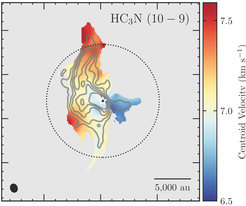A growing stellar system directly fed by the mother cloud

At a distance of just about 1000 light-years, the young star forming systems in the Perseus molecular cloud can be observed in detail with high-resolution telescopes. The system studied in this work, called Per-emb-2 (IRAS 03292+3039), is located in the box marked in the image.
In the general picture of star formation, a dense and cold region (called an envelope) forms inside a much larger and fluffier molecular cloud. Cloud material swirls and flows inwards towards the center of the envelope, where a future star will be born, the material becomes even more dense and flattens into a disk. Young protostars at the center of the disk feed and gain their mass directly from the disk. Now, for the very first time, a bright streamer of material connecting the outermost part of the envelope to the inner region where disks form has been observed in the Perseus Molecular Cloud. With the streamer helping to resupply the disk-scale region with more material as it is consumed by the binary system, the mother cloud can continue to help the young protostars and their protoplanetary disks to grow.
"Numerical simulations of disk formation usually focus on single protostar systems," explains Jaime Pineda from MPE, who lead the study. "Our observations take the idea one step further, by studying a streamer of chemically fresh material from large distances down to scales where we expect a disk to form around a close pair of young protostars." The astronomers used the Northern Extended Millimeter Array (NOEMA) to study the young Per-emb-2 (IRAS 03292+3039) proto-stellar binary system. The binary system has shown some variability or flickering in past observations, hinting that it may be an interesting target to study the impact of the environment on small scale star formation.

Image of the “streamer” feeding chemically fresh material from a distance of about 10,500 AU to the proto-star at the centre of the image. The three images use different molecules as tracers, indicated in the top right corner, and all show the streamer in action. The colour coding is according to the integrated intensity of the signal.
The team observed several molecules, which allowed them to measure the gas motions and discover a flow of material along the streamer from the outer regions of the envelope at a distance of about 10,500 AU down to the disk forming scales. Both the locations and the speed of the gas were well matched by a theoretical model of a stream of material free-falling from large to small scales, confirming that the streamer's dynamics are controlled by the most dense central region of the system. "It's not that often that theory and observations match up so clearly. We were excited to see this confirmation of what the telescope's images were trying to tell us," says co-author Dominique Segura-Cox from MPE. Estimates of the mass of material streamed into the inner core range from 0.1 to 1 solar mass, which is a substantial fraction of the total mass in the dense star-forming dense cloud (about 3 solar masses).

This plot shows the velocity of the material in the streamer, where blue (red) denotes a relatively small (high) velocity with respect to the core, the innermost gravitationally bound region of the newly forming star system. The velocity field is smooth and shows a clear velocity gradient, demonstrating a smooth flow of material from large to small scales.
“The streamer must indeed bring in chemically fresh material from the outer regions on a relatively short timescale,” adds Pineda. “The clear identification of such a large reservoir of fresh material in almost free-fall is remarkable.” This clearly shows that new material might shape the morphology and motions of the gas in young stellar systems. “The chemical composition of the growing and evolving protoplanetary disks will also be affected by this new phenomenon.”, concludes Paola Caselli, director at MPE and part of the team. “The molecule which allowed us to discover the streamer has three carbon atoms (HCCCN), which will then be available to enrich organic chemistry (on its way toward pre-biotic compounds) during the phase of planet assembly.” This new way to deliver material to the central region has important implications on the way young disks are formed and grow. However, it remains unclear how frequent and for how long this process could occur in the evolution of young stellar systems, so more detailed observations of young proto-stars are needed.














